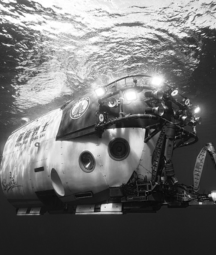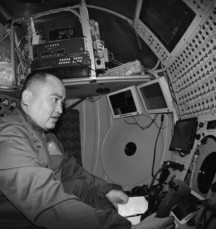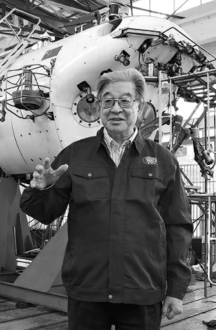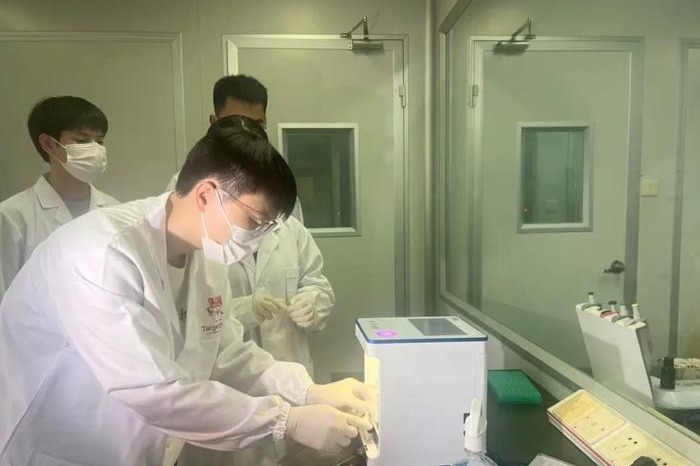Wave of innovation shows a world of wonder
Author inspired by creativity behind deep-sea submersible technology and the wonders it revealed, Yang Yang reports.

More than 20 years ago, when Gao Zhongtai was a reporter in Wuxi, East China's Jiangsu province, he started following news about the research and development of China's deep-sea manned submersibles at the China Ship Scientific Research Center.
The Wuxi-based center, China's largest ship and ocean engineering research institute, is behind the success of the country's three deep-sea manned submersibles: Jiaolong (Sea Dragon), Shenhai Yongshi (Deep Sea Warrior) and Fendouzhe (Striver).
Gao conducted interviews with the key scientists and engineers. However, his reporting was never going to get the story behind the story, or the intricate details about the research and development.
That is why Gao, in his 60s, wrote the book Shenqian (Diving Deep), published earlier this year, in which he recorded how scientists and engineers had developed the world's most advanced deep-sea manned submersibles in the last 20 years, starting from scratch.
Before Shenqian, Gao published nonfiction works like Dying to Survive, about a leukemia patient trying to save himself and other cancer patients by illegally buying generic drugs from India, and history novels set in the Spring and Autumn Period (770-476 BC) and the late Qing Dynasty (1644-1911). He is also a TV series screenwriter.
Since Fendouzhe, China's most advanced deep-sea manned submersible, successfully traveled to the Mariana Trench in the western Pacific Ocean, the deepest natural frontier on Earth, in 2020, Gao has always wanted to write a book about this feat.
Although he had been following the news for decades, he still found it difficult to understand the science and technology used on deep-sea manned submersibles. He spent a great deal of time trying to figure it out. To better discuss the motivation of exploring the ocean, he also researched more about the sea.
"If you know little about these two points, it'll be very difficult to write the book," he says.
Last year, with materials and interviews accumulated over the years, Gao completed the book in three months, trying to "dive deep into three questions" — human ideas about the ocean, why China develops advanced deep-sea manned submersibles, and the key technical challenges.
"Basically, there are three technical questions: how to dive, how to ascend from the deep sea, and how to communicate with the outside world," Gao says.
Take the giant titanium spherical cabin for example. Ideally, it should be lightweight yet withstand the high pressure trying to crush it in the abyss, while being big enough to carry three pilots and allow them to conduct their activities.
As the vehicles dive into deeper water, the surface of the cabin will take increasing pressure, and in the Mariana Trench, the pressure is 1,100 times of that on the ground.
When Chinese scientists started developing the country's first deepsea manned submersible Jiaolong in 2003, they did not even know what shape the vehicle should look like. The chief designer Xu Qi'nan, born in 1936, once worked on a submarine, and based on this experience, he estimated that the submersible should also be streamlined, says Gao.
At the start of the century, China was short of talent specializing in submersibles. Xu, a retired engineer returning from the United States, decided to nurture a research team and entrusted 12 young people with major tasks.
One of them was 24-year-old Ye Cong. At university, Ye studied ship engineering and before joining the team, his only experience with related research was his participation in the development of a submarine rescue ship that could dive to a depth of 600 meters.
Knowing nearly nothing about deep-sea manned submersibles, Ye got a vague idea about the possible contours of the vehicle by repeatedly watching Hollywood blockbuster Titanic.
The Jiaolong deep-sea submersible, with a 7,500-meter dive capacity, entered service in 2010, making China the fifth country in the world to have deep-sea exploration technology, after the United States, France, Russia and Japan. However, many of the key parts were created in foreign countries, including the metal sphere which was created in Russia.
Despite the success of Jiaolong, rather than directly develop a submersible that can reach the Mariana Trench, Chinese scientists decided to first create one using entirely domestic know-how that is capable of reaching a depth of 4,500 meters. Submersible Shenhai Yongshi was delivered to the Chinese Academy of Sciences in late 2017, conducting intensive scientific operations.
On Nov 10, 2020, Fendouzhe, carrying three people, dived to a depth of 10,909 meters in Challenger Deep, an 11,000-meter chasm located at the bottom of the Mariana Trench.
Fendouzhe was a significant improvement over its predecessors in almost every respect, including descending and ascending speeds, material toughness and battery capacity.
"But there is still big space for improvement. Now Chinese researchers are working on communication networks that can facilitate accurate positioning of submersibles in the deep sea," Gao says.
Another goal is to improve the submersibles' capacities to travel greater distances and stay longer underwater. Currently, Fendouzhe can stay six hours in the Mariana Trench, Gao says.
Besides, Chinese scientists hope to create larger cabins so as to carry five pilots for comprehensive scientific voyages with a better living environment.
While writing the book, Gao was impressed by the "black chimneys" found on the sea bed. They are basically mini volcanoes, superheating the water as they discharge minerals, metals and gases — at temperatures ranging between 200 C and 400 C — into the bitterly cold deep ocean from below the seafloor. They are also home to many living organisms.
"It amazed me that living creatures exist in such hot water," he says. "It's like another life system. Maybe it can provide another theory about where human beings come from."
He was also deeply impressed by the courage of Wang Pinxian, an academician of the Chinese Academy of Sciences. In 2018, 82-year-old Wang took the Jiaolong submersible and dived to the depth of 1,400 meters in the South China Sea three times within nine days and made many important scientific discoveries.
"There are many younger scientists who would not dare to make such a dive," Gao says.
For him, to explore the ocean is vitally important for the survival and development of human beings.
"The resources on land are limited. Humans have to explore the ocean, which accounts for 71 percent of the surface of our planet, and make use of it — perhaps in the future, even find a way to live in it, due to the explosive growth in the global population," he says.




Today's Top News
- China holds 2nd rehearsal for event marking 80th anniversary of victory over Japanese aggression, fascism
- Foreign athletes embrace culture, innovation at Chengdu World Games
- Meet again? Putin says: Next time in Moscow
- Zelensky to meet Trump in Washington on Monday
- Wang Yi to visit India from Monday
- Trump, Putin tout 'productive' Alaska talks without apparent breakthrough































